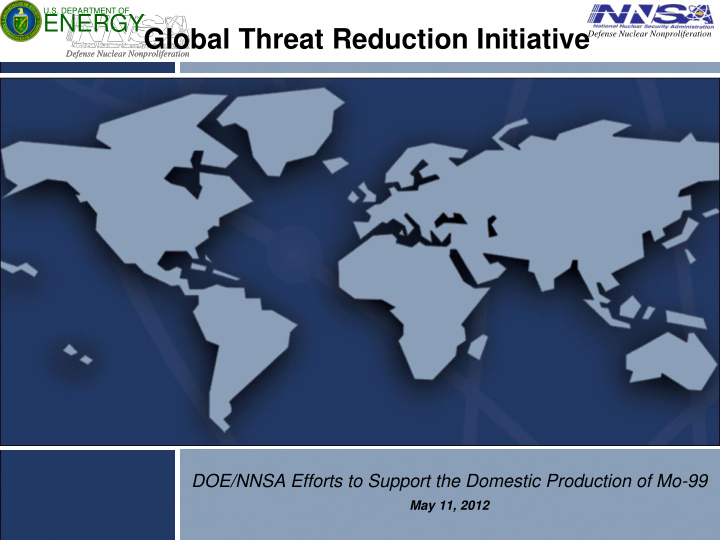



U.S. DEPARTMENT OF ENERGY Global Threat Reduction Initiative Defense Nuclear Nonproliferation Defense Nuclear Nonproliferation Defense Nuclear Nonproliferation Defense Nuclear Nonproliferation DOE/NNSA Efforts to Support the Domestic Production of Mo-99 May 11, 2012
Defense Nuclear Nonproliferation Mo-99 Policy Objectives* Balance improving nuclear security with maintaining a reliable medical isotope supply. • Ensure reliable supply of Mo-99 for 30 million worldwide patients annually • Eliminate HEU use in Mo-99 production • End subsidies and establish an economically-sound industry * Excerpt from Office of Science and Technology Policy presentation at December 4-7, 2011 Topical Meeting in Santa Fe, NM. 2
GTRI Mission & Program Goals Defense Nuclear Nonproliferation Convert Remove Protect M ission reduce and protect vulnerable nuclear and radiological material located at Protect high priority civilian sites Convert research Remove and dispose of nuclear and reactors and isotope excess nuclear and worldwide. radiological materials production facilities radiological from theft and from the use of highly materials. sabotage enriched uranium (HEU) to low enriched uranium (LEU) These efforts result in These efforts result in These efforts result in permanent threat permanent threat threat reduction by reduction by minimizing reduction by eliminating improving security on the and, to the extent bomb material at civilian bomb material remaining possible, eliminating the sites – each kilogram or at civilian sites – each need for HEU in civilian curie of this dangerous vulnerable building that applications – each material that is removed is protected reduces the reactor converted or reduces the risk of a risk until a permanent shut down eliminates a terrorist bomb. threat reduction source of bomb material. solution can be implemented. 3 3
GTRI & Mo-99 Defense Nuclear Nonproliferation International & U.S. Domestic Approaches • Under its long-standing HEU minimization mission, GTRI provides assistance to research reactors and isotope production facilities to convert from the use of HEU to LEU. • GTRI’s mission includes accelerating the establishment of a reliable U.S. domestic supply of Mo-99 produced without the use of HEU. INTERNATIONAL U.S. DOMESTIC EFFORTS EFFORTS Accelerating the Assisting global Mo-99 establishment of production facilities to commercial non-HEU- convert to use LEU targets based Mo-99 production in the United States Achieve HEU Minimization Establish reliable supplies of Mo-99 produced without HEU 4
GTRI & Mo-99 Defense Nuclear Nonproliferation Strategy for Reliable Non-HEU-Based Mo-99 Supply Global Mo-99 Market – Major Producers HEU Non-HEU NTP Radioisotopes ANSTO Covidien IRE AECL-Nordion (South Africa) (Australia) (Netherlands) (Belgium) (Canada) NTP Radioisotopes ANSTO Covidien IRE AECL-Nordion (South Africa) (Australia) (Netherlands) (Belgium) (Canada) NTP Radioisotopes ANSTO Covidien IRE 2016 (South Africa) (Australia) (Netherlands) (Belgium) U.S. Domestic Mo-99 Projects 1 2 3 4 5
GTRI and U.S. Domestic Mo-99: Defense Nuclear Nonproliferation Cooperative Agreement Partners Objective: To accelerate existing commercial projects to meet at least 100% of the U.S. demand of Mo-99 produced without HEU. Neutron Capture: • On September 30, 2009, NNSA awarded a cooperative agreement to General Electric-Hitachi for $2.3M to pursue neutron capture technology. On February 7, 2012, GEH announced its business decision to suspend progress on the project indefinitely due to market conditions. LEU Solution Reactor Technology: • On September 30, 2009, NNSA awarded a cooperative agreement to Babcock and Wilcox (B&W) for $9.1M to pursue the LEU solution reactor technology. Accelerator Technology: • On September 29, 2010, NNSA awarded a limited-scope cooperative agreement to NorthStar Medical Radioisotopes, LLC for $500,000 to pursue accelerator technology. On September 19, 2011, NNSA awarded an additional cooperative agreement for $2.3M. • On September 29, 2010, NNSA awarded a limited-scope cooperative agreement to Morgridge Institute for Research for $500,000 to pursue accelerator technology. On April 30, 2012, NNSA awarded an additional cooperative agreement for $10.2M. Each cooperative agreement project is currently limited to $25M, under a 6 50% - 50% cost-share arrangement.
U.S. National Laboratories Support Defense Nuclear Nonproliferation to Mo-99 Production GTRI makes the expertise of the U.S. National Laboratories available to: • Support technical development of each of the Mo-99 technical pathways • Ensure the expertise at the national laboratories is available to support the acceleration of commercial projects using non-HEU technologies All work packages funded by NNSA outside the cooperative agreement are open- sourced, non-proprietary, non-critical-path activities. If requested, the work conducted by the laboratories outside of the cooperative agreements is available to help inform the NRC. 7
Recommend
More recommend